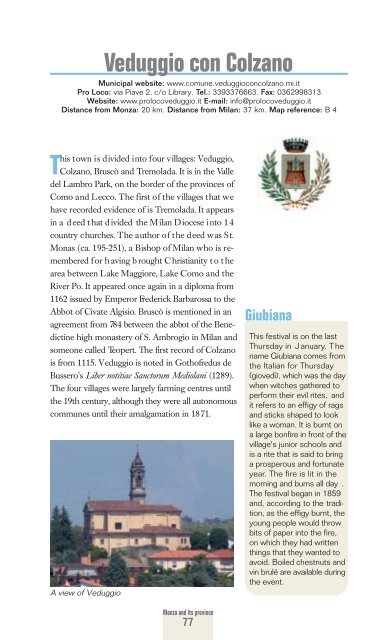A PROVINCE TO BE EXPLORED - Visita Milano
A PROVINCE TO BE EXPLORED - Visita Milano
A PROVINCE TO BE EXPLORED - Visita Milano
Create successful ePaper yourself
Turn your PDF publications into a flip-book with our unique Google optimized e-Paper software.
Veduggio con Colzano<br />
Municipal website: www.comune.veduggioconcolzano.mi.it<br />
Pro Loco: via Piave 2, c/o Library. Tel.: 3393376663. Fax: 0362998313<br />
Website: www.prolocoveduggio.it E-mail: info@prolocoveduggio.it<br />
Distance from Monza: 20 km. Distance from Milan: 37 km. Map reference: B 4<br />
This town is divided into four villages: Veduggio,<br />
Colzano, Bruscò and Tremolada. It is in the Valle<br />
del Lambro Park, on the border of the provinces of<br />
Como and Lecco. The first of the villages that we<br />
have recorded evidence of is Tremolada. It appears<br />
in a d eed t hat d ivided the M ilan D iocese i nto 1 4<br />
country churches. The author of the deed was St.<br />
Monas (ca. 195-251), a Bishop of Milan who is remembered<br />
f or h aving b rought C hristianity t o t he<br />
area between Lake Maggiore, Lake Como and the<br />
River Po. It appeared once again in a diploma from<br />
1162 issued by Emperor Frederick Barbarossa to the<br />
Abbot of Civate Algisio. Bruscò is mentioned in an<br />
agreement from 784 between the abbot of the Benedictine<br />
high monastery of S. Ambrogio in Milan and<br />
someone called Teopert. The first record of Colzano<br />
is from 1115. Veduggio is noted in Gothofredus de<br />
Bussero's Liber notitiae Sanctorum Mediolani (1289).<br />
The four villages were largely farming centres until<br />
the 19th century, although they were all autonomous<br />
communes until their amalgamation in 1871.<br />
A view of Veduggio<br />
Giubiana<br />
This festival is on the last<br />
Thursday in J anuary. T he<br />
name Giubiana comes from<br />
the Italian for Thursday<br />
(giovedì), which was the day<br />
when witches gathered to<br />
perform their evil rites, and<br />
it refers to an effigy of rags<br />
and sticks shaped to look<br />
like a woman. It is burnt on<br />
a large bonfire in front of the<br />
village's junior schools and<br />
is a rite that is said to bring<br />
a prosperous and fortunate<br />
year. The fire is lit in the<br />
morning and burns all day .<br />
The festival began in 1859<br />
and, according to the tradition,<br />
as the effigy burnt, the<br />
young people would throw<br />
bits of paper into the fire,<br />
on which they had written<br />
things that they wanted to<br />
avoid. Boiled chestnuts and<br />
vin brulé are available during<br />
the event.<br />
Monza and its province<br />
77

















